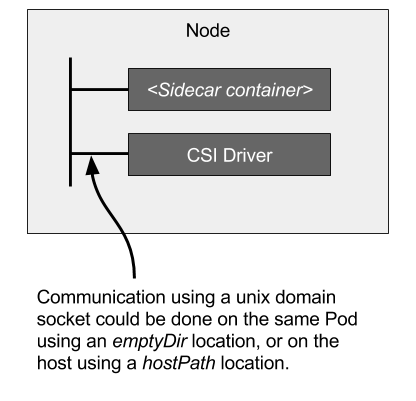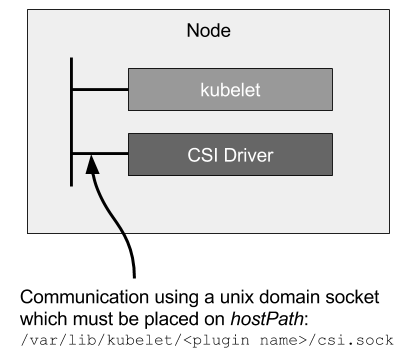Deploying CSI Driver on Kubernetes
This page describes to CSI driver developers how to deploy their driver onto a Kubernetes cluster.
Overview
A CSI driver is typically deployed in Kubernetes as two components: a controller component and a per-node component.
Controller Plugin
The controller component can be deployed as a Deployment or StatefulSet on any node in the cluster. It consists of the CSI driver that implements the CSI Controller service and one or more sidecar containers. These controller sidecar containers typically interact with Kubernetes objects and make calls to the driver's CSI Controller service.
It generally does not need direct access to the host and can perform all its operations through the Kubernetes API and external control plane services. Multiple copies of the controller component can be deployed for HA, however it is recommended to use leader election to ensure there is only one active controller at a time.
Controller sidecars include the external-provisioner, external-attacher, external-snapshotter, and external-resizer. Including a sidecar in the deployment may be optional. See each sidecar's page for more details.
Communication with Sidecars
Sidecar containers manage Kubernetes events and make the appropriate calls to the CSI driver. The calls are made by sharing a UNIX domain socket through an emptyDir volume between the sidecars and CSI Driver.
RBAC Rules
Most controller sidecars interact with Kubernetes objects and therefore need to set RBAC policies. Each sidecar repository contains example RBAC configurations.
Node Plugin
The node component should be deployed on every node in the cluster through a DaemonSet. It consists of the CSI driver that implements the CSI Node service and the node-driver-registrar sidecar container.
Communication with Kubelet
The Kubernetes kubelet runs on every node and is responsible for making the CSI Node service calls. These calls mount and unmount the storage volume from the storage system, making it available to the Pod to consume. Kubelet makes calls to the CSI driver through a UNIX domain socket shared on the host via a HostPath volume. There is also a second UNIX domain socket that the node-driver-registrar uses to register the CSI driver to kubelet.
Driver Volume Mounts
The node plugin needs direct access to the host for making block devices and/or filesystem mounts available to the Kubernetes kubelet.
The mount point used by the CSI driver must be set to Bidirectional to allow Kubelet on the host to see mounts created by the CSI driver container. See the example below:
containers:
- name: my-csi-driver
...
volumeMounts:
- name: socket-dir
mountPath: /csi
- name: mountpoint-dir
mountPath: /var/lib/kubelet/pods
mountPropagation: "Bidirectional"
- name: node-driver-registrar
...
volumeMounts:
- name: registration-dir
mountPath: /registration
volumes:
# This volume is where the socket for kubelet->driver communication is done
- name: socket-dir
hostPath:
path: /var/lib/kubelet/plugins/<driver-name>
type: DirectoryOrCreate
# This volume is where the driver mounts volumes
- name: mountpoint-dir
hostPath:
path: /var/lib/kubelet/pods
type: Directory
# This volume is where the node-driver-registrar registers the plugin
# with kubelet
- name: registration-dir
hostPath:
path: /var/lib/kubelet/plugins_registry
type: Directory
Deploying
Deploying a CSI driver onto Kubernetes is highlighted in detail in Recommended Mechanism for Deploying CSI Drivers on Kubernetes.
Enable privileged Pods
To use CSI drivers, your Kubernetes cluster must allow privileged pods (i.e. --allow-privileged flag must be set to true for both the API server and the kubelet). This is the default in some environments (e.g. GCE, GKE, kubeadm).
Ensure your API server are started with the privileged flag:
$ ./kube-apiserver ... --allow-privileged=true ...
$ ./kubelet ... --allow-privileged=true ...
Note: Starting from Kubernetes 1.13.0, --allow-privileged is true for kubelet. It'll be deprecated in future kubernetes releases.
Enabling mount propagation
Another feature that CSI depends on is mount propagation. It allows the sharing of volumes mounted by one container with other containers in the same pod, or even to other pods on the same node. For mount propagation to work, the Docker daemon for the cluster must allow shared mounts. See the mount propagation docs to find out how to enable this feature for your cluster. This page explains how to check if shared mounts are enabled and how to configure Docker for shared mounts.
Examples
- Simple deployment example using a single pod for all components: see the hostpath example.
- Full deployment example using a DaemonSet for the node plugin and StatefulSet for the controller plugin: TODO
More information
For more information, please read CSI Volume Plugins in Kubernetes Design Doc.

